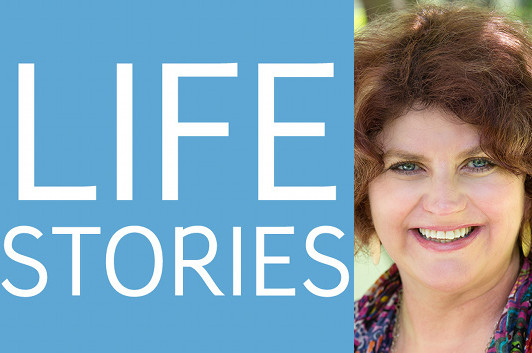Life Stories #51: Ellen Stimson
Subscribe to Life Stories in iTunes
In this episode of Life Stories, the podcast series where I talk to memoir writers about their lives and the art of writing memoir, Ellen Stimson and I discuss Mud Season—the story of, as the subtitle says, “how one woman’s dream of moving to Vermont, raising children, chickens and sheep, and running the old country store pretty much led to one calamity after another.” And, as I say at the start of our conversation, this memoir does exactly what it says on the cover.
But Stimson got through all those calamities—including getting in way over her head with the whole country store thing—and, when I got to a point where I could ask what she’d tell other people who, like her and her family, decide they want to make a drastic change in their lives, to do something other than what they’re doing, in a place other than where they are now, her response was clear: “Do it.” (That’s not to say she wouldn’t do things differently if she had a second chance, and we talk about that, too…) Stimson’s life story is a great example of recovering from our mistakes and setbacks and eventually find our way to an ideal path.
Listen to Life Stories #51: Ellen Stimson (MP3 file); or download this file directly by right-clicking (Mac users, option-click). You can also subscribe to Life Stories in iTunes, where you can catch up with earlier episodes and be alerted whenever a new one is released. (And if you are an iTunes subscriber, please consider rating and reviewing the podcast!)
4 November 2013 | life stories |
A2A: Marek Waldorf & Thomas McGonigle
With his debut novel, The Short Fall, recently out, Marek Waldorf engaged in a series of email exchanges with the author Thomas McGonigle. The book that they’re talking about here, St. Patrick’s Day, Dublin 1974, isn’t actually out yet, although fragments have been appearing in literary magazines over the years—and, apparently, Dalkey Archive Press does plan to publish it; it’s merely a question of when. In the meantime, I’m delighted they’ve agreed to share their conversation as an Author2Author post.
 Marek Waldorf: I wanted to open with a quote from St. Patrick’s Day, Dublin 1974. Just a sentence because your sentences are wonders to behold, either at a swoop or counting the surprises:
Marek Waldorf: I wanted to open with a quote from St. Patrick’s Day, Dublin 1974. Just a sentence because your sentences are wonders to behold, either at a swoop or counting the surprises:
“That woman, the Wife of the Poet, would follow a coffin hoping it would spring a leak and she could lie under it with mouth open ready to sup on the fluids to nourish her through the rest of her miserable life of hanging out, having waited for him to finish up the drink for the night so she could get him home so he could vomit in the privacy of her scorn for him.”
Compared to the new book, both Petkov and Patchogue seem closer in form to collage. Patchogue tracks a reinsertion—a going-to and a coming-away—but it’s also coming at the reader from every direction: I was constantly looking over my shoulder, paging back for the dangling/missing threads (somebody always seems to be sneaking up on you). Because Dublin has a supreme “through-line” for St. Patrick’s Day, 1974, I found it easier to catch the other lines of reminiscence either refracting out from it or (more likely) in one of those hall-of mirror glimpses. In other words, the new book negotiates the layers of memory and loss with greater ease, or maybe more luxuriantly. So there’s my overarching question: How does the mood of this book, its projection of memory, “dictate” the style? Do you see a kind of mellowing in both subject matter & form here, or would you reject that term? And in the two earlier—jumpier—novels, how do you think about what goes where? Do you imagine the reader moving sequentially through these works, playing hopscotch, or making the time to do both?
3 November 2013 | author2author |


 Our Endless and Proper Work is my new book with Belt Publishing about starting (and sticking to) a productive writing practice.
Our Endless and Proper Work is my new book with Belt Publishing about starting (and sticking to) a productive writing practice. 
